Today’s Wonder of the Day was inspired by Kylie. Kylie Wonders, “what is an electromagnet?” Thanks for WONDERing with us, Kylie!
Ding dong! Someone's at the front door!
Do you have a doorbell at your house? Maybe you live in an apartment and have a bunch of doorbells – and maybe even an intercom – at your entrance. You probably don't give it much thought, but doorbells make life a lot easier. With a simple push of a button, your friends, neighbors, and even door-to-door salespeople can announce their presence and request entry into your humble abode.
If you have a doorbell at your home, you probably take it for granted. After all, it's just a simple device, right? You press a button that completes a circuit that triggers a sound. Compared to modern technology, a doorbell may seem a bit boring.
However, it's the doorbell's simplicity that makes it such a marvel. These little devices put the scientific principle of electromagnetism into action in a useful — and tuneful! — way.
The heart of a doorbell is an electromagnet. Electromagnets are coils of wire wrapped around a small piece of magnetic metal. When electricity passes through the wire, it creates a magnetic field around the wire.
When you press a doorbell button, you complete an electrical circuit that allows household electricity to flow through the doorbell's internal electromagnet. The magnetic field generated by the electromagnet is then used to power a mechanism that creates the doorbell sound.
Doorbells are low-voltage devices. This means they require relatively little energy to operate. An important part of a doorbell mechanism is the transformer. The transformer converts regular 120-volt household current to the lower voltage (usually somewhere between 6-16 volts) required by the doorbell.
A simple chime doorbell uses the magnetic field created by the electromagnet to move a magnetic piston to strike two tone bars. This makes that “ding dong" sound you've probably heard many times.
The simplest type of doorbell is the buzzer. In a buzzer doorbell, the electromagnet operates a self-interrupting circuit. When the button is pressed, the circuit closes and the electromagnet moves a contact arm. When the contact arm moves, it interrupts the circuit and the electromagnet stops. When it stops, the contact arms falls back into position, completing the circuit and starting the process over again.
This cycle repeats quickly over and over again as long as the button of the doorbell is held down. The sound of the contact arm hitting the electromagnet multiple times every second creates the buzzing noise you hear as the doorbell.
Today, electronic doorbells are becoming more popular. Electronic doorbells don't have electromagnets or tone bars. When you press the button of an electronic doorbell, a special circuit — called an integrated circuit — is triggered that in turn causes a recorded digital sound to play.




